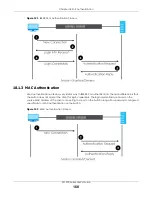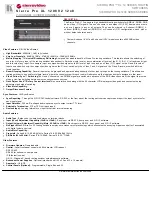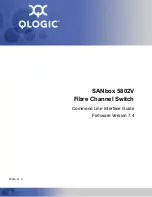
Chapter 21 Classifier
XS1930 Series User’s Guide
182
Weight
Enter a number between 0 and 65535 to specify the rule’s weight. When the match order is in manual
mode in the
Classifier Global Setting
screen, a higher weight means a higher priority.
Log
Select this option to have the Switch create a log message when the rule is applied and record the
number of matched packets in a particular time interval.
Note: Make sure you also enable logging in the
Classifier Global Setting
screen.
Count
Select this option to have the Switch count how many times the rule is applied.
Time
Range
Select the name of the pre-configured schedule that you want to apply to the rule. The rule will be
active only at the scheduled date and/or time.
If you select
None
, the rule will be active all the time.
Ingress Port
Port
Type the port number to which the rule should be applied. You may choose one port only or all ports
(
Any
).
Trunk
Select
Any
to apply the rule to all trunk groups.
To specify a trunk group, select the second choice and type a trunk group ID.
Layer 2
Specify the fields below to configure a layer 2 classifier.
VLAN
VLAN
Select
Any
to classify traffic from any VLAN or select the second option and specify the source VLAN
ID in the field provided.
Priority
Priority
Select
Any
to classify traffic from any priority level or select the second option and specify a priority
level in the field provided.
Ethernet
Type
Select an Ethernet type or select
Other
and enter the Ethernet type number in hexadecimal value.
Refer to
for information.
Source
MAC
Address
Select
Any
to apply the rule to all MAC addresses.
To specify a source, select
MAC/Mask
to enter the source MAC address of the packet in valid MAC
address format (six hexadecimal character pairs) and type the mask for the specified MAC address to
determine which bits a packet’s MAC address should match.
Enter “f” for each bit of the specified MAC address that the traffic’s MAC address should match. Enter
“0” for the bit(s) of the matched traffic’s MAC address, which can be of any hexadecimal
character(s). For example, if you set the MAC address to 00:13:49:00:00:00 and the mask to
ff:ff:ff:00:00:00, a packet with a MAC address of 00:13:49:12:34:56 matches this criteria. If you leave the
Mask
field blank, the Switch automatically sets the mask to ff:ff:ff:ff:ff:ff.
Destination
MAC
Address
Select
Any
to apply the rule to all MAC addresses.
To specify a destination, select
MAC/Mask
to enter the destination MAC address of the packet in
valid MAC address format (six hexadecimal character pairs) and type the mask for the specified MAC
address to determine which bits a packet’s MAC address should match.
Enter “f” for each bit of the specified MAC address that the traffic’s MAC address should match. Enter
“0” for the bit(s) of the matched traffic’s MAC address, which can be of any hexadecimal
character(s). For example, if you set the MAC address to 00:13:49:00:00:00 and the mask to
ff:ff:ff:00:00:00, a packet with a MAC address of 00:13:49:12:34:56 matches this criteria. If you leave the
Mask
field blank, the Switch automatically sets the mask to ff:ff:ff:ff:ff:ff.
Layer 3
Specify the fields below to configure a layer 3 classifier.
Table 82 Advanced Application > Classifier > Classifier Configuration (continued)
LABEL
DESCRIPTION
Содержание XS1930 Series
Страница 17: ...17 PART I User s Guide ...
Страница 38: ...38 PART II Technical Reference ...
Страница 153: ...Chapter 13 Spanning Tree Protocol XS1930 Series User s Guide 153 Figure 112 MSTP and Legacy RSTP Network Example ...
Страница 187: ...Chapter 21 Classifier XS1930 Series User s Guide 187 Figure 134 Classifier Example ...
















































